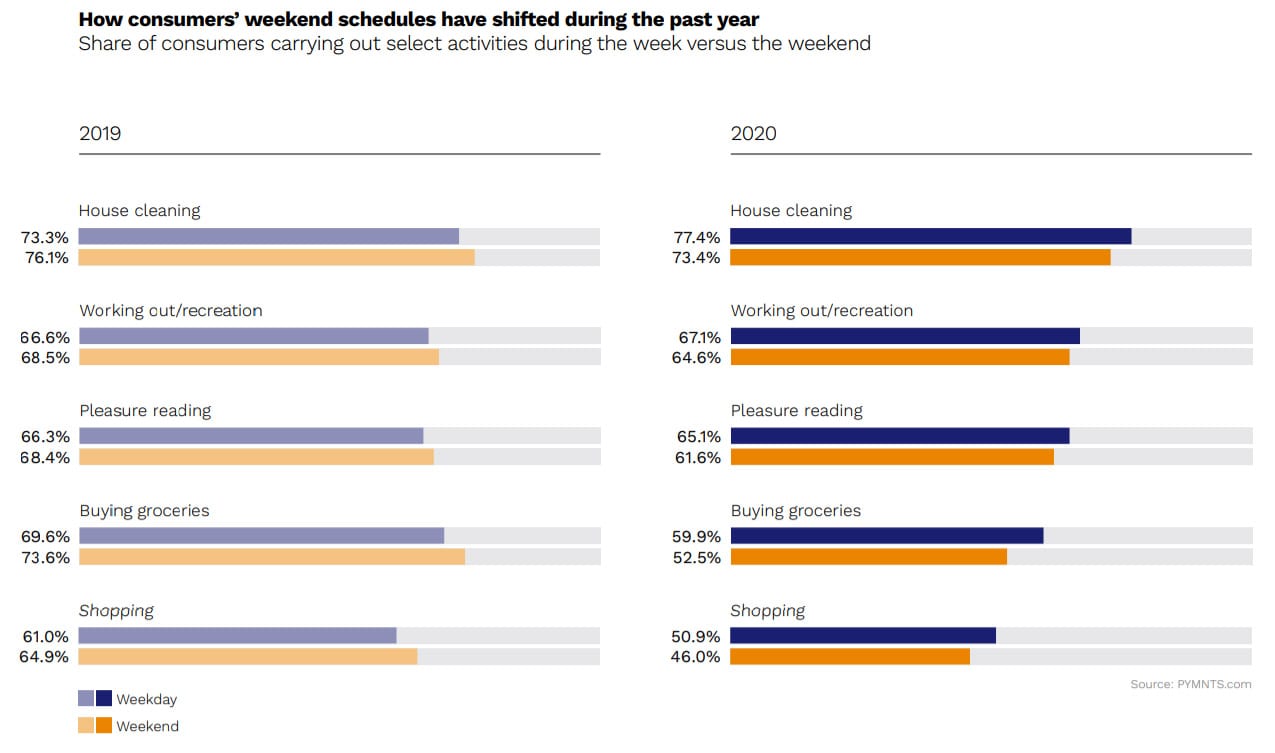Reopening Shopping: Digital Reality Overshadows Economic Optimism

The cross-currents around the pandemic and the impending recovery continue to swirl. As of April 17, 85 million Americans had been vaccinated. Yet, new strains of the virus and anti-vaxx protests have put some states smack in the middle of the pandemic including North and South Dakota. In the E.U. and Asia, the situation has returned to critical status, with India and Brazil still inundated with cases. Globally, according to the World Health Organization, the number of new cases per week has nearly doubled over the past two months.
Yet, in the U.S., the recovery party is on, led by JPMorgan CEO Jamie Dimon who said last Wednesday that the newly flush consumer is coiled and ready to strike. Couple comments like that with the 9.8 percent retail sales jump for March and things certainly look to be on the upswing.
Even Macy’s, which has struggled during the pandemic, is fired up. “You’ve got young women that are now able to put a prom date on the calendar and they’re coming to our stores and websites,” said CEO Jeff Gennette at a JPMorgan conference this week, per CNBC. “You’ve got the mother of the bride. So, you definitely have wedding dates that you’re starting to see pop up onto people’s calendars, and you’re seeing them over at the bride category. And then, just people that are going out more, and so you see that in casual day dresses.”
So the cross-currents continue to swirl. It’s worth a reminder as they do that returning to shopping’s pre-pandemic patterns is not a smart bet. As PYMNTS data has repeatedly demonstrated over the last year of consumer studies, the patterns are going to have to be different because the consumers walking back into stores will not be the same ones that stepped out of the stores a little over a year ago. Because apart from the venue, consumers’ shopping habits have shifted over the last year.
 The when of shopping, for example, is not what it used to be, according to PYMNTS/Visa data, consumers have simply time-shifted how they shop. Shopping for groceries or other goods pre-pandemic was very much a weekend-locked activity, but that is rapidly changing as consumers working from home and shopping from home are realizing the clock is more open to scheduling flexibility. A PYMNTS’ survey shows that 46 percent of consumers are now shopping for retail items on the weekend in 2020, whereas 65 percent did so in 2019, a decline of 48 million U.S. consumers.
The when of shopping, for example, is not what it used to be, according to PYMNTS/Visa data, consumers have simply time-shifted how they shop. Shopping for groceries or other goods pre-pandemic was very much a weekend-locked activity, but that is rapidly changing as consumers working from home and shopping from home are realizing the clock is more open to scheduling flexibility. A PYMNTS’ survey shows that 46 percent of consumers are now shopping for retail items on the weekend in 2020, whereas 65 percent did so in 2019, a decline of 48 million U.S. consumers.
And that shift is more prevalently seen in the younger the consumer demographic, or the more connected the consumer. The share of superconnected consumers shopping for retail items from home is up 126 percent since 2019, meaning the share more than doubled in a single year. Something similar can be said for bridge millennials, who are 105 percent more likely to be retail shopping from home than last year.
 Shifts in shopping behavior carried through the end of 2020, the massive holiday shopping rush and into 2021 as the very early phases of recovery began as vaccines have been distributed more. According to PYMNTS’ Holiday Retrospective Report: Merchant Insights For 2021 And Beyond, 40 percent of shoppers used digital wallets to pay for gifts, 54 percent increase compared to 2019. Payment innovations like QR codes and installment credit also gained remarkable traction during the holiday season, with 62 percent of consumers increasing their use of the former option and 47 percent turning more to alternative credit solutions like buy now, pay later (BNPL) plans.
Shifts in shopping behavior carried through the end of 2020, the massive holiday shopping rush and into 2021 as the very early phases of recovery began as vaccines have been distributed more. According to PYMNTS’ Holiday Retrospective Report: Merchant Insights For 2021 And Beyond, 40 percent of shoppers used digital wallets to pay for gifts, 54 percent increase compared to 2019. Payment innovations like QR codes and installment credit also gained remarkable traction during the holiday season, with 62 percent of consumers increasing their use of the former option and 47 percent turning more to alternative credit solutions like buy now, pay later (BNPL) plans.
And as vaccines have gone out, PYMNTS data has continued to reflect consumers’ interest in getting back out there for the purpose of having fun, going to events and seeing loved ones — but are less enthused to re-engage with the physical world for performing essential activities like work and grocery shopping.
Sixty-two percent of consumers who are grocery shopping in stores less often than they did before the pandemic say they do not want to do so as much as they did before the pandemic began, for example. Consumers are most likely to switch between digital and brick-and-mortar channels for leisurely, nonessential products like games, books and clothing, for example, and they are least likely to switch between channels when it comes to specialty products like building materials and auto parts.
Eighty percent of consumers who purchase clothing, accessories, games, hobbies and books do so both online and in person. By contrast, among those who buy hardware, building material and auto parts, only 69 percent buy them using both digital and physical channels.
Consumer habits around shopping, the data demonstrates, are changing. They may be going back to stores, but they are being selective about how they want to shop, when they get there and are looking for more flexibility in when they have to be there are all.